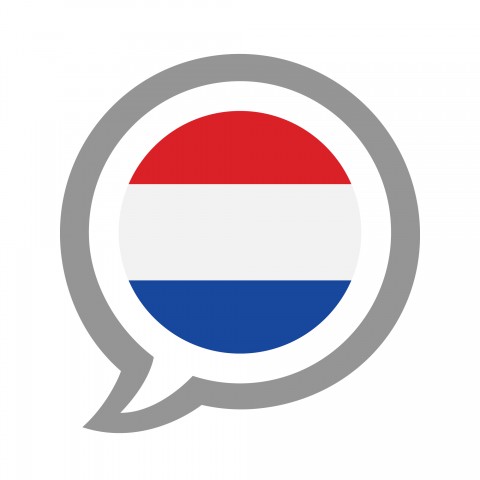
Do you have a Dutch girlfriend or boyfriend, or has an attractive Dutchie caught your eye? Then learning how to express your feelings in the Dutch language is the first step you should take toward creating a new relationship or strengthening the bond between you and your lover.
Of course, there are the basics. For example…
How do you say “I love you,” in Dutch? That’s Ik hou van jou. And how about “my love”? That could be mijn lieverd or mijn liefje.
The Dutch may not be the most expressive people when it comes to love, but they do have their own ways of confessing their feelings and revealing their love to someone. With the right words, you’ll come a long way in your relationship—but try not to be too dramatic or clingy. The Dutch are very down-to-earth, and they view excessive romanticism as a mark of desperation.
Learn to talk about love in Dutch with this useful guide from DutchPod101.com. We’ve provided a variety of Dutch love phrases for every phase of your romantic relationship, from confessing your affection and falling in love all the way to getting married and starting a family. And if that’s still not enough, we’ll even introduce you to some Dutch endearment terms and must-know Dutch love quotes.
Let’s get to it!

Impress your Dutch love with these Dutch romantic phrases.
 Table of Contents
Table of Contents
- First Contact: Dutch Pick-up Lines and More
- Take it to the Next Level: How Do You Say “I Love You,” in Dutch?
- Take it One Step Further: “Will You Marry Me?” and More
- Dutch Endearment Terms: “My Love” in Dutch and More
- Must-know Dutch Love Quotes
- How DutchPod101 Can Help You Learn More Dutch
1. First Contact: Dutch Pick-up Lines and More
You’re in a bar and you spot some nice Dutchie you’d like to get to know…but how do you make first contact? While the Dutch value a direct approach in all things, it’s still important to know how to start the conversation. Have a look at these Dutch pick-up lines and other useful Dutch love phrases for when you’ve just met someone.
| Kom je hier vaker? Ik ken je ergens van. | “Do you come here often?” “I think I’ve seen you before.” |
| Hoe heet je? | “What’s your name?” |
- → What more can you say? Have a look at these 10 Lines You Need for Introducing Yourself.
| Wil je dansen? Wil je met me dansen? | “Do you want to dance?” “Do you want to dance with me?” |
| Wil je wat drinken? Ik betaal dit rondje. | “Can I buy you a drink?” “Let me get this round.” |
| In the Netherlands, it’s not customary that the man pays for everything. Rather, it’s quite common for couples to “go Dutch” and split the bill. However, when you meet someone new, offering a drink can be a good way to show your interest. While it’s less common for a girl to buy a guy a drink, this is definitely an option as well. | |
| Heb je een vriend? Heb je een vriendin? | “Do you have a boyfriend?” “Do you have a girlfriend?” |
| The Dutch are direct, so they’re used to non-subtle ways of asking if someone is single. You could also ask: Ben je single? (“Are you single?”) | |
| Het was leuk met jou.I k zou het leuk vinden om je nog een keer te zien. | “I had a great time with you.” “I’d like to see you again.” |
| Zullen we nog eens afspreken? Zullen we binnenkort wat drinken? | “Shall we meet another time?” “Shall we have a drink soon?” |
| In the Netherlands, a common first date is to have drinks together at a bar at night. Going for dinner is far less common, as it can be viewed as awkward if you don’t know the other person very well. | |

Are you ready to invite someone on a date in Dutch?
| Mag ik je telefoonnummer? Mag ik je mijn telefoonnummer geven? | “Can I get your phone number?” “Can I give you my number?” |
| It’s more common to ask for someone’s phone number than to ask if you may give your number to someone, and both men and women can do so. That said, giving your phone number to someone might be seen as more courteous. If your potential date is interested, they will either return the favor right away or call you later. | |
- → Now that you’ve made your move, you’ll want to know the Most Common Phrases You’ll Need for a Date.
→ Did someone ask you out on a date, but you’re not interested? Find out how to politely decline with these Ways to Reject an Invitation.
2. Take it to the Next Level: How Do You Say “I Love You,” in Dutch?
You went on that first date and many more. You’re in love and ready to take it to the next level. So, what’s “I love you,” in Dutch? And what else can you say to really win their affections? Here are several romantic Dutch phrases you can use to express your feelings.
| Ik vind je leuk. | “I like you.” |
| As mentioned before, the Dutch are not very expressive about their love. Saying this phrase to someone you’ve only just met may be seen as too fast or forward. It’s more common to express this after you’ve seen the other person several times. | |
| Ik mis je. | “I miss you.” |
| Ik heb zin om je weer te zien. | “I look forward to seeing you again.” |
| Ik denk aan jou. | “I’m thinking about you.” |
| Ik ben gek op jou. | “I’m crazy about you.” |
| Je bent zo mooi. | “You’re so beautiful.” |
| Ik ben verliefd op jou. | “I am in love with you.” |
| Wil je verkering met mij? Wil je een relatie met mij? Zullen we het officieel maken? | “Do you want to be in a relationship with me?” “Do you want to be in a relationship with me?” “Shall we make it official?” |
| Verkering is another word used to refer to a romantic relationship. Although it’s a common word, it might be perceived as a bit childish. If you’d prefer to stay on the safe side, use the word relatie (“relationship”). It has the same meaning, but it’s a more neutral word. If you’ve been dating your Dutchie for a while but the relationship has not become “official” yet, then you might want to use the last option. | |
| Ik houd van jou. Ik houd zielsveel van jou. | “I love you.” “I love you with heart and soul.” |
| Fun fact: Dutch people often use the phrase Ik hou van jou, with the d dropped from houd. Although the spelling is officially wrong, it’s a very common way to write the phrase. Where does this habit come from? The d might have been dropped simply because it’s not pronounced when the word is spoken. | |

Ready to write some love letters in Dutch?
- → Are you looking for some other romantic Dutch phrases to declare your undying love? Our list of Love Phrases for Valentine’s Day might be just what you need.
3. Take it One Step Further: “Will You Marry Me?” and More
You’ve expressed your feelings successfully, it’s been reciprocated, and you’re officially in a happy relationship. Are you ready to take it one step further? Here are all the Dutch love phrases you need to steer your relationship toward the future you want. We’ve gathered key phrases for expressing true love in Dutch, meeting the parents, moving in together, getting married, and even having a baby.
| Wij zijn voor elkaar bestemd. Jij bent de liefde van mijn leven. Ik kan niet zonder jou. | “We are made for each other.” “You are the love of my life.” “I can’t live without you.” |
| These romantic Dutch phrases are not used very often, so make sure you only say them in the right setting and that they come from the heart. The Dutch don’t take words like these lightly. | |
| Ik wil graag dat je mijn ouders ontmoet. | “I would like for you to meet my parents.” |
| As the Dutch move out of their parents’ place at a relatively young age and often move to another city when going to study, meeting the parents is a big deal in Dutch culture. | |
| Wil je met mij samenwonen? | “Would you like to move in together?” |
| Wil je met me trouwen? | “Do you want to marry me?” |

Pop the question in Dutch.
| Ik wil graag een kindje met jou. | “I would like to have a baby with you.” |
4. Dutch Endearment Terms: “My Love” in Dutch and More
What’s next, then? You’ll need some Dutch endearment terms to express your love each and every day. In the Netherlands, it’s very common to use endearment terms when talking to the people you love, whether it be your partner or your friends and family.
| Lieverd Schatje Liefje Dropje Lekker ding Knapperd | “Dear” “Cutie” “Little dear” “Sweetie” “Delicious thing” “Beautiful” |
| These are just some popular options, but there are many more! The same endearment terms also come in a lot of different forms and shapes, such as: lieffie, droppie, schatteke, knappie. It’s all a matter of preference, and many Dutch couples also use personal pet names. | |

What Dutch endearment term would you use?
5. Must-know Dutch Love Quotes
As you might have expected from the not-so-romantic Dutch, there is no overload of romantic love quotes in the Dutch language. And the quotes that do exist tend to have a down-to-earth undertone. That said, here are the most popular quotes about love in Dutch:
| Dutch | De liefde kan niet van één kant komen. |
| Literally | “Love cannot come from one side.” |
| Equivalent | It takes two to tango. |
| This is one of the down-to-earth Dutch love quotes that’s quite popular in the Netherlands. It shows the Dutch attitude about love, which is that love should come from both sides: If you want to make it work, both parties will have to contribute. | |
| Dutch | De liefde van een man gaat door de maag. |
| Literally | “A man’s love goes through the stomach.” |
| This humorous Dutch love quote may also say something about their not-so-romantic nature. This is a very popular Dutch quote, and it even has its own song. It can also be used for women, children, or even for animals. People may even say it about their own cat: De liefde van een kat gaat door de maag. (“The love of a cat goes through the stomach.”) | |
| Dutch | Ongelukkig in het spel, gelukkig in de liefde. |
| Literally | “Unlucky in the game, happy in love.” |
| Equivalent | Lucky at cards, unlucky in love. |
| This love quote in Dutch is nearly identical to its English counterpart. Those who always lose in gambling often have a happy love life, and vice-versa. What do you think about that? Is it true for you? | |
| Dutch | Oude liefde roest niet. |
| Literally | “Old love does not rust.” |
| This beautiful Dutch quote, with an identical English counterpart, also has its own song from the famous Dutch 80s band VOF De Kunst. They sing: Oude liefde roest niet, maar verdwijnt net zoals jij. (“Old love does not rust, but disappears just like you.”) | |
- → Find more love inspiration in our free vocabulary list of quotes on Love. Or go for those bittersweet Break-Up quotes.
6. How DutchPod101 Can Help You Learn More Dutch

You’re ready to find some Dutch love!
In this article, you learned how to say “I love you,” in Dutch and many more useful Dutch love phrases. You’re now prepared to get your flirt on, express your love, and even take it a step further with a solid marriage proposal. You also know what endearment terms to use for your Dutch lieverd (“dear”) and have some old Dutch love quotes to fall back on when you want to spice things up.
Did we forget any important Dutch love phrases you know? What’s your favorite romantic Dutch phrase or endearment term?
There’s still a lot more to learn, and nothing will make your Dutch lover swoon more than mastering their native tongue. Make sure to explore DutchPod101.com and take advantage of our numerous vocabulary lists with audio recordings and other useful free resources to boost your Dutch studies.
Would you like some 1-on-1 coaching? Then consider upgrading to a Premium PLUS subscription, which will give you access to our MyTeacher service. Here, you can learn more about Dutch love and life with your own private teacher and really master the Dutch language. Through personalized feedback and pronunciation advice, you’ll catch on in no time.

Dutch Love Phrases: How to Say “I Love You,” in Dutch

Do you have a Dutch girlfriend or boyfriend, or has an attractive Dutchie caught your eye? Then learning how to express your feelings in the Dutch language is the first step you should take toward creating a new relationship or strengthening the bond between you and your lover.
Of course, there are the basics. For example…
How do you say “I love you,” in Dutch? That’s Ik hou van jou. And how about “my love”? That could be mijn lieverd or mijn liefje.
The Dutch may not be the most expressive people when it comes to love, but they do have their own ways of confessing their feelings and revealing their love to someone. With the right words, you’ll come a long way in your relationship—but try not to be too dramatic or clingy. The Dutch are very down-to-earth, and they view excessive romanticism as a mark of desperation.
Learn to talk about love in Dutch with this useful guide from DutchPod101.com. We’ve provided a variety of Dutch love phrases for every phase of your romantic relationship, from confessing your affection and falling in love all the way to getting married and starting a family. And if that’s still not enough, we’ll even introduce you to some Dutch endearment terms and must-know Dutch love quotes.
Let’s get to it!

Impress your Dutch love with these Dutch romantic phrases.
 Table of Contents
Table of Contents
- First Contact: Dutch Pick-up Lines and More
- Take it to the Next Level: How Do You Say “I Love You,” in Dutch?
- Take it One Step Further: “Will You Marry Me?” and More
- Dutch Endearment Terms: “My Love” in Dutch and More
- Must-know Dutch Love Quotes
- How DutchPod101 Can Help You Learn More Dutch
1. First Contact: Dutch Pick-up Lines and More
You’re in a bar and you spot some nice Dutchie you’d like to get to know…but how do you make first contact? While the Dutch value a direct approach in all things, it’s still important to know how to start the conversation. Have a look at these Dutch pick-up lines and other useful Dutch love phrases for when you’ve just met someone.
| Kom je hier vaker? Ik ken je ergens van. | “Do you come here often?” “I think I’ve seen you before.” |
| Hoe heet je? | “What’s your name?” |
- → What more can you say? Have a look at these 10 Lines You Need for Introducing Yourself.
| Wil je dansen? Wil je met me dansen? | “Do you want to dance?” “Do you want to dance with me?” |
| Wil je wat drinken? Ik betaal dit rondje. | “Can I buy you a drink?” “Let me get this round.” |
| In the Netherlands, it’s not customary that the man pays for everything. Rather, it’s quite common for couples to “go Dutch” and split the bill. However, when you meet someone new, offering a drink can be a good way to show your interest. While it’s less common for a girl to buy a guy a drink, this is definitely an option as well. | |
| Heb je een vriend? Heb je een vriendin? | “Do you have a boyfriend?” “Do you have a girlfriend?” |
| The Dutch are direct, so they’re used to non-subtle ways of asking if someone is single. You could also ask: Ben je single? (“Are you single?”) | |
| Het was leuk met jou.I k zou het leuk vinden om je nog een keer te zien. | “I had a great time with you.” “I’d like to see you again.” |
| Zullen we nog eens afspreken? Zullen we binnenkort wat drinken? | “Shall we meet another time?” “Shall we have a drink soon?” |
| In the Netherlands, a common first date is to have drinks together at a bar at night. Going for dinner is far less common, as it can be viewed as awkward if you don’t know the other person very well. | |

Are you ready to invite someone on a date in Dutch?
| Mag ik je telefoonnummer? Mag ik je mijn telefoonnummer geven? | “Can I get your phone number?” “Can I give you my number?” |
| It’s more common to ask for someone’s phone number than to ask if you may give your number to someone, and both men and women can do so. That said, giving your phone number to someone might be seen as more courteous. If your potential date is interested, they will either return the favor right away or call you later. | |
- → Now that you’ve made your move, you’ll want to know the Most Common Phrases You’ll Need for a Date.
→ Did someone ask you out on a date, but you’re not interested? Find out how to politely decline with these Ways to Reject an Invitation.
2. Take it to the Next Level: How Do You Say “I Love You,” in Dutch?
You went on that first date and many more. You’re in love and ready to take it to the next level. So, what’s “I love you,” in Dutch? And what else can you say to really win their affections? Here are several romantic Dutch phrases you can use to express your feelings.
| Ik vind je leuk. | “I like you.” |
| As mentioned before, the Dutch are not very expressive about their love. Saying this phrase to someone you’ve only just met may be seen as too fast or forward. It’s more common to express this after you’ve seen the other person several times. | |
| Ik mis je. | “I miss you.” |
| Ik heb zin om je weer te zien. | “I look forward to seeing you again.” |
| Ik denk aan jou. | “I’m thinking about you.” |
| Ik ben gek op jou. | “I’m crazy about you.” |
| Je bent zo mooi. | “You’re so beautiful.” |
| Ik ben verliefd op jou. | “I am in love with you.” |
| Wil je verkering met mij? Wil je een relatie met mij? Zullen we het officieel maken? | “Do you want to be in a relationship with me?” “Do you want to be in a relationship with me?” “Shall we make it official?” |
| Verkering is another word used to refer to a romantic relationship. Although it’s a common word, it might be perceived as a bit childish. If you’d prefer to stay on the safe side, use the word relatie (“relationship”). It has the same meaning, but it’s a more neutral word. If you’ve been dating your Dutchie for a while but the relationship has not become “official” yet, then you might want to use the last option. | |
| Ik houd van jou. Ik houd zielsveel van jou. | “I love you.” “I love you with heart and soul.” |
| Fun fact: Dutch people often use the phrase Ik hou van jou, with the d dropped from houd. Although the spelling is officially wrong, it’s a very common way to write the phrase. Where does this habit come from? The d might have been dropped simply because it’s not pronounced when the word is spoken. | |

Ready to write some love letters in Dutch?
- → Are you looking for some other romantic Dutch phrases to declare your undying love? Our list of Love Phrases for Valentine’s Day might be just what you need.
3. Take it One Step Further: “Will You Marry Me?” and More
You’ve expressed your feelings successfully, it’s been reciprocated, and you’re officially in a happy relationship. Are you ready to take it one step further? Here are all the Dutch love phrases you need to steer your relationship toward the future you want. We’ve gathered key phrases for expressing true love in Dutch, meeting the parents, moving in together, getting married, and even having a baby.
| Wij zijn voor elkaar bestemd. Jij bent de liefde van mijn leven. Ik kan niet zonder jou. | “We are made for each other.” “You are the love of my life.” “I can’t live without you.” |
| These romantic Dutch phrases are not used very often, so make sure you only say them in the right setting and that they come from the heart. The Dutch don’t take words like these lightly. | |
| Ik wil graag dat je mijn ouders ontmoet. | “I would like for you to meet my parents.” |
| As the Dutch move out of their parents’ place at a relatively young age and often move to another city when going to study, meeting the parents is a big deal in Dutch culture. | |
| Wil je met mij samenwonen? | “Would you like to move in together?” |
| Wil je met me trouwen? | “Do you want to marry me?” |

Pop the question in Dutch.
| Ik wil graag een kindje met jou. | “I would like to have a baby with you.” |
4. Dutch Endearment Terms: “My Love” in Dutch and More
What’s next, then? You’ll need some Dutch endearment terms to express your love each and every day. In the Netherlands, it’s very common to use endearment terms when talking to the people you love, whether it be your partner or your friends and family.
| Lieverd Schatje Liefje Dropje Lekker ding Knapperd | “Dear” “Cutie” “Little dear” “Sweetie” “Delicious thing” “Beautiful” |
| These are just some popular options, but there are many more! The same endearment terms also come in a lot of different forms and shapes, such as: lieffie, droppie, schatteke, knappie. It’s all a matter of preference, and many Dutch couples also use personal pet names. | |

What Dutch endearment term would you use?
5. Must-know Dutch Love Quotes
As you might have expected from the not-so-romantic Dutch, there is no overload of romantic love quotes in the Dutch language. And the quotes that do exist tend to have a down-to-earth undertone. That said, here are the most popular quotes about love in Dutch:
| Dutch | De liefde kan niet van één kant komen. |
| Literally | “Love cannot come from one side.” |
| Equivalent | It takes two to tango. |
| This is one of the down-to-earth Dutch love quotes that’s quite popular in the Netherlands. It shows the Dutch attitude about love, which is that love should come from both sides: If you want to make it work, both parties will have to contribute. | |
| Dutch | De liefde van een man gaat door de maag. |
| Literally | “A man’s love goes through the stomach.” |
| This humorous Dutch love quote may also say something about their not-so-romantic nature. This is a very popular Dutch quote, and it even has its own song. It can also be used for women, children, or even for animals. People may even say it about their own cat: De liefde van een kat gaat door de maag. (“The love of a cat goes through the stomach.”) | |
| Dutch | Ongelukkig in het spel, gelukkig in de liefde. |
| Literally | “Unlucky in the game, happy in love.” |
| Equivalent | Lucky at cards, unlucky in love. |
| This love quote in Dutch is nearly identical to its English counterpart. Those who always lose in gambling often have a happy love life, and vice-versa. What do you think about that? Is it true for you? | |
| Dutch | Oude liefde roest niet. |
| Literally | “Old love does not rust.” |
| This beautiful Dutch quote, with an identical English counterpart, also has its own song from the famous Dutch 80s band VOF De Kunst. They sing: Oude liefde roest niet, maar verdwijnt net zoals jij. (“Old love does not rust, but disappears just like you.”) | |
- → Find more love inspiration in our free vocabulary list of quotes on Love. Or go for those bittersweet Break-Up quotes.
6. How DutchPod101 Can Help You Learn More Dutch

You’re ready to find some Dutch love!
In this article, you learned how to say “I love you,” in Dutch and many more useful Dutch love phrases. You’re now prepared to get your flirt on, express your love, and even take it a step further with a solid marriage proposal. You also know what endearment terms to use for your Dutch lieverd (“dear”) and have some old Dutch love quotes to fall back on when you want to spice things up.
Did we forget any important Dutch love phrases you know? What’s your favorite romantic Dutch phrase or endearment term?
There’s still a lot more to learn, and nothing will make your Dutch lover swoon more than mastering their native tongue. Make sure to explore DutchPod101.com and take advantage of our numerous vocabulary lists with audio recordings and other useful free resources to boost your Dutch studies.
Would you like some 1-on-1 coaching? Then consider upgrading to a Premium PLUS subscription, which will give you access to our MyTeacher service. Here, you can learn more about Dutch love and life with your own private teacher and really master the Dutch language. Through personalized feedback and pronunciation advice, you’ll catch on in no time.

Dutch Negation Rules: How to Say No in Dutch

The word nee (“no”) is crucial in any language. It allows you to express your desires, clarify things, and even talk about your experiences. Saying no may sometimes be viewed as rude, insensitive, or socially disruptive, but it’s simply a necessary part of life and of society.
Luckily, the Dutch are quite direct and are not afraid of using some true Dutch negations. While we may sometimes sugarcoat things, honesty and the Dutch directness triumph over being vague or fake.
In this guide, you’ll learn everything you need to know about negation in the Dutch language:
- The basic Dutch negation rules
- Common negative words with lots of examples
- Negative questions and their matching negative answers
Ready? Let’s go!
 Table of Contents
Table of Contents
- The Basics of Dutch Negation – Using Niet (“Not”)
- Some Important Negation Rules
- More Negative Words
- Negative Questions
- How DutchPod101 Can Help You Learn More Dutch
1. The Basics of Dutch Negation – Using Niet (“Not”)

How to say no in Dutch…
A. When to use niet
The most basic way to make a Dutch sentence negative is to simply add the word niet (“not”). For example:
- Ik ben niet moe. (“I am not tired.”)
- Hij woont niet hier. (“He doesn’t live here.”)
- Wij werken niet. (“We don’t work.”)
- Ik werk in Amsterdam, niet in Rotterdam. (“I work in Amsterdam, not in Rotterdam.”)
Because this word is so crucial to negation in Dutch grammar, it’s important that you know exactly when to use it. The Dutch use the word niet in the following cases:
- To negate any element that is not a noun, such as verbs, adjectives, or thoughts.
- Verbs: Ik fiets niet. (“I don’t cycle.”)
- Adjectives: Zij is niet oud. (“She is not old.”)
- Thoughts: Ik denk niet dat ik mooi ben. (“I don’t think I am beautiful.”)
- To negate nouns that are preceded by a definite article or a possessive pronoun.
- Definite article: Zij is niet de burgemeester van Amsterdam. (“She is not the mayor of Amsterdam.”)
- Possessive pronoun: Dat is niet mijn auto. (“That’s not my car.”)
So you now know when to use niet, but where does it go in a sentence?
B. How to use niet

Do you know where to place the word niet?
The position of niet in a sentence depends on what you’re negating.
In case of an adverb or adjective, niet is put right in front of it:
- Adverb: Zijn auto is niet snel. (“His car isn’t fast.”)
- Adjective: Mijn kat is niet dik. (“My cat isn’t fat.”)
- → Come up with more examples using these 50 Most Common Adjectives.
In most other cases, the word niet comes after the middle part of the sentence, where you usually find the time, manner, and place:
- Time: Zij was vorige week niet op werk. (“She was not at work last week.”)
- Manner: Ik kon door het drukke verkeer niet op tijd op het werk komen. (“I could not get to work on time because of the busy traffic.”)
However, regarding the “place” of the sentence, the situation is a bit different. The word niet usually comes before it when the place indicates a direction:
- Place [direction]: Wij gaan niet naar Breda. (“We are not going to Breda.”)
However, if you want to stress that something isn’t (or will not be done) a certain way, but rather another way, then you have to put niet in front of the time, manner, and place:
- Ik rijd niet met jou naar huis vandaag, maar met hem. (“I’m not driving home with you today, but with him.”)
These cases also relate to the fact that the word niet always goes before a preposition:
- Ik kom niet uit Frankrijk. (“I am not from France.”)
- Zij woont niet in Rotterdam. (“She doesn’t live in Rotterdam.”)
2. Some Important Negation Rules

Learn how to say no in Dutch with these important Dutch negation rules.
A. Negation with the word geen (“none”)
Another common way to make a negative sentence in Dutch is to use the word geen (“none”). Here are a couple of situations where you would use this Dutch negation word:
- When negating a noun that would have needed the word een (“a” / “an”) in a positive sentence.
- Zij heeft geen baan. (“She doesn’t have a job.”)
- When negating plural and uncountable nouns that do not have an article in front of them.
- Ik heb geen boeken bij me. (“I don’t have any books with me.”)
Geen is always connected to a noun. And as you can see, it always comes before the noun.
- → Think of more examples with these 50 Most Common Nouns.
B. How to use the verbs “to be” and “to have” in negative forms
Two of the most essential verbs in Dutch are zijn (“to be”) and hebben (“to have”). Unfortunately, both of these verbs are irregular. This makes it imperative to learn not only their conjugations, but also how they work in the context of a negative sentence.
Let’s have a look at them in the present simple tense:
| Subject | Hebben conjugation Dutch (“to have”) | Zijn conjugation Dutch (“to be”) |
| Ik (“I”) | heb (“have”) | ben (“am”) |
| Jij, u (“You” casual, “you” formal) | hebt (“have”) | bent (“are”) |
| Hij, zij, het (“He,” “she,” “it”) | heeft (“has”) | is (“is”) |
| Wij (“We”) | hebben (“have”) | zijn (“are”) |
| Jullie (“You” plural) | hebben (“have”) | zijn (“are”) |
| Zij (“They”) | hebben (“have”) | zijn (“are”) |
Let’s start with some examples of sentences using the verb hebben in negative form:
- Ik heb geen auto. (“I don’t have a car.”)
- Wij hebben geen haast. (“We are not in a hurry.”)
- Zij heeft geen kwade bedoelingen. (“She has no bad intentions.”)
As you may have noticed, when using the verb hebben, we use the negation word geen. This is logical, as hebben is mostly used when talking about possessions (and therefore nouns).
Now have a look at some Dutch negations with the verb zijn:
- Ik ben niet moe. (“I am not tired.”)
- Zij is niet jarig. (“It’s not her birthday.”)
- Wij zijn niet naar Frankrijk op vakantie gegaan. (“We did not go on holiday to France.”)
As you can see, we use niet when negating this verb. This is because zijn is mostly used to describe something about one’s identity, feelings, or situation. Therefore, prepositions, adjectives, and adverbs are often used in these sentences.
C. Negative Dutch expressions
You now know the basic Dutch negation rules. Let’s now go over some essential negative statements that will come in handy when traveling in the Netherlands.
| Nederlands (“Dutch”) | Engels (“English”) |
| Ik heb geen tijd. | “I don’t have time.” |
| Ik weet het niet. | “I don’t know.” |
| Ik begrijp het/je niet. | “I don’t understand it/you.” |
| Ik heb geen pen. | “I don’t have a pen.” |
| Ik vind het niet leuk. | “I don’t like it.” |
| Ik heb geen idee. | “I have no idea.” |
| Ik heb geen zin. | “I do not feel like it.” |
| Ik weet niet waar ik ben. | “I don’t know where I am.” |
| Ik ben het niet met je eens. | “I don’t agree with you.” |
| Geen probleem. | “No problem.” |
| Het maakt niet uit. | “It doesn’t matter.” |
- → Would you like to be able to make a negative Dutch sentence when you’re angry? Then also have a look at these Dutch Phrases to Use When You’re Angry.
- → Or are you rather feeling sad? Learn the Top 21 Words for Negative Emotions.
3. More Negative Words
Below is a table of the most useful words and phrases for performing negation in the Dutch language. For your convenience, we’ve provided a couple of examples for each word.

Feel strong using these Dutch negation words.
| Nooit (“Never”) |
|
| Niemand (“Nobody”) |
|
| Niets (“Nothing”) |
|
| Nog niet (“Not yet”) |
Nog niet is used to make a negative sentence nicer and not so abrupt. For example, if someone asks: Is de bakkerij open?(“Is the bakery open?”) You could say: Nee, de bakkerij is niet open. (“No, the bakery isn’t open.”) But that would be quite abrupt. It’s nicer to say: Nee, de bakkerij is nog niet open. (“No, the bakery isn’t open yet.”) |
| Nergens (“Nowhere”) |
|
| Niet meer (“Not anymore”) |
|
| Niet eens (“Not even”) |
|
| Niet altijd (“Not always”) |
|
| Noch … noch … (“Neither … nor …”) |
|
- → Oops, have you been too negative? Make it up with these Top 15 Compliments.
4. Negative Questions
Do you know how to make a question negative in Dutch? Below, you’ll find information on how to do this for both open-ended and closed-ended questions!
A. Negative Open Questions
An open question starts with an interrogative word (who, what, where, how, etc.). These questions require at least a simple sentence as a reply; you can’t just answer with “yes” or “no.”
There’s a special structure used for questions like this. The question word comes first, the conjugated verb second, and the subject third:
Question word + Verb + Subject + Niet
Let’s have a look at two simple examples:
- Waarom lach je niet? (“Why don’t you laugh?”)
- Wie gaat er niet? (“Who’s not going?”)
Got it? Then let’s move on to some more complex negative questions and their possible negative replies.
| Wat (“What”) | Wat ga jij morgen niet doen? (“What aren’t you going to do tomorrow?”) | Ik ga morgen niet bij mijn ouders op bezoek. (“I’m not going to visit my parents tomorrow.”) |
| Waarom (“Why”) | Waarom is je vriendin niet bij jou? (“Why is your girlfriend not here?”) | Mijn vriendin is niet hier want ze is op vakantie. (“My girlfriend is not here because she is on holiday.”) |
| Waar (“Where”) | Waar ben jij nog nooit geweest? (“Where have you never been to?”) | Ik ben nog nooit in Marokko geweest. (“I have never been to Morocco.”) |
| Wie (“Who”) | Wie wil jij niet meer zien? (“Who don’t you want to see anymore?”) | Ik wil mijn ex vriendje Pieter echt nooit meer zien. (“I never want to see my ex boyfriend Pieter again.”) |
B. Negative Closed Questions
Another common type of question Dutch people use is the closed question; these are the questions that can be answered with a simple “yes” or “no.” Questions like these have a different word order, with the verb coming first:
Verb + Subject + Niet
For example:
- Kom je niet? (“Aren’t you coming?”)
- Werkt hij niet? (“Doesn’t he work?”)
As you can see here, the subject and verb are inverted to create yes-or-no questions.
Remember that when jij or je (“you”) follows the verb, the -t at the end of the verb is dropped:
- Ga je morgen niet naar school? (“Are you not going to school tomorrow?”)
- Instead of: Je gaat morgen niet naar school. (“You are not going to school tomorrow.”)
- Heb je vandaag niet met je oma gepraat? (“Didn’t you talk to your grandmother today?”)
- Instead of: Je hebt vandaag niet met je oma gepraat. (“You didn’t talk with your grandmother today.”)
The answer for these questions is simple: Nee. (“No.”)
- → For more Dutch question examples, don’t forget to have a look at our list of the Top 25 Questions You Need to Know on DutchPod101.com.
5. How DutchPod101 Can Help You Learn More Dutch

You now know How to say no in Dutch.
In this guide, you’ve learned all about Dutch negations, from the basics of negation in Dutch to more advanced rules. You’ve also picked up a few useful words for negation and have a better idea of how to use them.
Do you already have a favorite Dutch negation word or negative sentence? Or do you still feel like you need some help with the Dutch negation rules?
If you’re feeling stuck, remember that DutchPod101 also has tons of vocabulary lists with audio recordings and other free resources to help you master this and many other parts of the Dutch language.
Would you like to practice with your own private teacher? Then make use of Premium PLUS MyTeacher service and get personal one-on-one coaching. Through interactive exercises, pronunciation advice, and personalized feedback, you’ll really master those Dutch negative sentences and questions!
Start saying no in Dutch like a native with DutchPod101!

Can You Learn Dutch Fast? Here’s How Long it Will Take.

How long does it take to learn Dutch?
This is one of the most frequently asked questions from aspiring Dutch learners, but it has no definite answer. It depends on many things, such as your native language, educational background, experience with languages, exposure, and motivation. It also depends on what “learning Dutch” means to you: Are you hoping to achieve a beginner, intermediate, or advanced level? These are all different goals with different timeframes. But whatever level you wish to achieve, there are some great tools you can use to learn Dutch faster.
In this article, you’ll learn how to realistically estimate how long it will take to learn Dutch, depending on your background and the proficiency level you have in mind. Then, we’ll give you some useful strategies you can employ to really master this language.

How long does it take to learn Dutch?
 Table of Contents
Table of Contents
- The Many Factors Involved
- From Beginner to Advanced
- Dutch Learning Strategies to Help You Learn Faster
- How DutchPod101 Can Help You Learn Dutch Faster
1. The Many Factors Involved
There are a few factors involved in determining how long it takes to learn the Dutch language. Because these things will impact your learning progress, you should take them into consideration as you plan your course of study.
Your Native Language vs. Dutch
Knowing a language with similar roots as Dutch will make it easier and quicker for you to learn this language. If you’re reading this article, it means your English level is already really strong, and this is great news for your Dutch learning!
Dutch is very similar to English and German, as these three languages are all part of the Indo-European family of languages and belong to the Germanic branch. This makes it much easier for English- and German-speakers to pick up the language, compared to speakers of other languages. (And lucky for you, Dutch won’t make you put up with difficult grammar like that found in German!)
So if you speak one of these languages, even if it’s not your native language, it will give you a headstart in your Dutch learning process.
Your Language Learning Experience
Have you ever learned another language before? If you already speak a foreign language, this knowledge and experience will help you a lot when learning a third language.
Your brain is accustomed to the challenges of language learning and you already know how to study a language. You’re familiar with the best ways to memorize vocabulary, practice your conversation skills, and understand those tricky tenses. Languages have a certain logic to them, and the more languages you learn, the more you start to understand how their grammar and structure work in general.
For these reasons, bilinguals often find it easier to learn a third language. If this is the case for you, you’ll probably save yourself quite a lot of time when learning Dutch.
Your Motivation
Why do you want to learn Dutch?
Do you just want to learn another language? Are you going to work in the Netherlands? Are you planning to study in this country? Or are you dating a nice Dutchie?
Whatever your reason may be, this motivation will impact your level of commitment and the amount of time you’re willing to invest in learning Dutch. Your motivation will also help you continue your studies and convince you not to stop, even when things get difficult. If you have a strong motivation, you’ll have a strong will to work hard and learn fast.

Have you already found your motivation to learn Dutch?
Your Approach
Your learning method plays a key role in how fast you’ll make progress. For a good learning method, it’s often advisable to combine different learning techniques, such as taking online Dutch lessons, finding a language exchange partner to help you practice your conversation skills, and listening to Dutch music or movies to train your listening skills. And of course, how successful your learning method is also depends on how much time you’re willing to invest in your studies.
Don’t worry about this yet, though. We’ll discuss some useful Dutch learning strategies in a few moments!
2. From Beginner to Advanced
Now, for the main topic at hand: How long does it take to learn Dutch as an English speaker?
According to FSI (Foreign Service Institute), an American government institution in charge of foreign language teaching to American diplomats and officials, it takes English speakers around 24 weeks of intensive classroom study to reach a general professional proficiency in Dutch.
However, be aware that this is based on the FSI approach. This is a very intensive study routine where students are taught in small classes of around 6 students, spend 6 hours daily with a teacher, and do 2 hours of self-study each day. In other words, it takes around 600 classroom hours for a student to be able to work professionally with the language.
Let’s see what this means for the different Dutch proficiency levels.
We’ll use the CEFR system (Common European Framework of Reference for Languages). This classification shows one’s proficiency level in a foreign language on a six-point scale, from A1 for beginners to C2 for those who have mastered a language. In this article, we’ll focus only on the A1 / B1 / C1 levels (not the second level for each), as these are a good reflection of what it takes to achieve the beginner, intermediate, and advanced levels.
- → Speaking of which, if you’re interested in doing a Dutch language exam, we have a complete guide to help you successfully pass these tests.
1 – Beginner Level

Do you want to reach the Dutch beginner level?
Let’s start with the beginner level, A1.
- ★ How long does it take to reach A1? Around 80-100 hours.
At this level, you can:
|
To be able to do this, you need to build a foundation to start understanding how the language works. This means studying things like:
- Word order
- Present tense
- Basic conjugation
Vocabulary is also important, but in this beginning phase, your focus will be on building lots of different sentences using few words. Don’t clutter your brain yet with too much vocabulary. With some basic nouns, verbs, and adjectives, you’ll be able to have basic conversations.
Try to practice your pronunciation from the beginning, as this will prevent you from making the same mistakes when you’re improving your Dutch in the next stages. Listen to a lot of Dutch music to become familiar with the pronunciation, practice your speaking skills with others, and record yourself so you can listen to your own pronunciation and find things to improve.
At the beginner level, flashcards will come in handy. You can use them to remember words, simple phrases, useful questions, or conjugated verbs—basically anything you want or need.
- → Also have a look at the DutchPod101 Absolute Beginner lesson pathway. This is the perfect pathway for learning the Dutch basics, containing 25 lessons (about 5.5 hours of material) that cover topics ranging from self-introductions to writing a postcard.
2 – Intermediate Level
B1 is the intermediate level.
- ★ How long does it take to reach B1? Around 350 to 400 hours.
At this level, you can:
|
To reach B1, you have to pass through the beginner level (A1) and the lower-intermediate level (A2). So there’s quite some ground to cover!
As you progress toward this stage, you’ll be learning more about Dutch-language patterns, structures, and vocabulary. This is also the level where you’ll start learning new tenses and new types of words, such as adverbs. You’ll start to understand the pronouns better, which will allow you to make smoother sentences. Using all of this new knowledge, you’ll be able to get into more details when speaking or writing Dutch.
If you’re not studying Dutch at school or university, this would be a good time to start some lessons with a teacher at a language school. Alternatively, you could try to find some affordable online coaching to make sure you’re on the right track.
- → Have a look at the DutchPod101 Lower Intermediate lessons to break out of the beginner level and pass through to the intermediate level. In only 25 lessons (around 4.5 hours), you’ll notice some improvement.
3 – Advanced Level
So, how long does it take to learn Dutch fluently? C1 is the advanced level.

Ready to achieve the advanced level?
- ★ How long does it take to reach C1? Around 850 to 900 hours.
At this level, you can:
|
Now you know how long it takes to learn Dutch fluently. You have to pass through the A1, A2, B1, and B2 levels. It’s double the time and effort of the intermediate level, but it’s worth it!
When you reach this stage, you’ll have expanded your vocabulary greatly, you understand the tenses, and you’re able to write and speak Dutch at a high level. You feel confident as you (almost) fully understand the language and you can discuss the most complex topics in Dutch.
To reach such a level of proficiency, you can, of course, use language classes or online teachers. However, try to really immerse yourself in the language as well. Read Dutch books, watch Dutch TV or movies, listen to music in Dutch, and try to find a native speaker you can talk with on a regular basis.
This all helps, but at the end of the day, the best way to improve your Dutch to an advanced level is to live in the country or to spend a few months there.
- → Have a look at our official curated pathway for Level 5, the best tool to help you become an advanced Dutch learner. These 50 lessons (around 2 hours) will help you go from fully intermediate to an advanced learner.
3. Dutch Learning Strategies to Help You Learn Faster
As we mentioned before, how long it takes to learn Dutch fluently depends on your exposure to the language, how much time and effort you put into it, and the strategies you use.
With the right strategies, you’ll be able to learn Dutch faster and more effectively!
1 – Make Use of Online Classes
Wondering how to learn Dutch online? We hear you!
With online classes, you can learn Dutch anywhere and anytime you want. There are online classes for every level and they’re more affordable than private lessons or language schools. They’re also the most flexible option, as you can adapt them to your schedule.
There are many websites you can choose from. Some are entirely free, while others have a mixture of free resources and paid resources with advanced services. Try to choose a website where you can track your progress and work over time; this way, you can really be aware of your improvement.

Be efficient and learn where and when you can.
- → Check out DutchPod101 to see what online lessons we offer. Even without a paid subscription, you can access a lot of free content, including vocabulary lists, a YouTube channel, and countless lessons for students at every level.
2 – Make Learning Dutch Fun
Try to make learning Dutch as enjoyable as possible—learning a new language shouldn’t be boring.
Of course there are some boring parts, such as grammar rules or those endless lists of verb conjugations, but try to mix it up with some entertaining learning tools. For example, you might enjoy watching a Dutch TV show with subtitles, or listening to Dutch music and trying to translate or understand the lyrics. Studying this way will make you more inclined to continue your Dutch studies!
- → The Netherlands has some great Dutch TV shows and series for beginners, intermediate learners, and advanced students. We recommend giving them a try!
3 – Practice is Key
To really learn a language, you have to practice it a lot. So try speaking, reading, writing, and listening in Dutch as much as you can. It’s okay to make mistakes, and you don’t even need that many words or an extensive knowledge of complicated grammar rules to express yourself.
Try to put everything you learn into practice, as this is truly the only way to improve your Dutch. Really immerse yourself in the language through TV series, books, music, or even podcasts. Start writing Dutch stories and talk to every Dutch person you meet. You can do it!
4 – Use Word Lists to Build Up a Solid Vocabulary
Are you struggling to practice the language because you feel like you don’t have a solid vocabulary yet? Then use vocabulary word lists to expand your personal word bank. You can choose a topic you find interesting and learn words related to that topic. DutchPod101 has vocabulary lists on many topics, such as love, family, animals, work, and more.
You may even want to set yourself some vocabulary learning goals. For example, to memorize one or two vocabulary lists a week, or one new word a day.
5 – Create a Study Schedule and Set Some Goals
When learning a new language, structure is key. Language learning is a big task, and there’s so much to learn. Therefore, it’s very important that you create a clear study schedule and set some goals. This will give you the motivation to continue and not give up. With every goal you achieve, you know you’re improving and you’ll be motivated to continue with your other goals. A study schedule gives you the consistency needed to achieve them.
How DutchPod101 Can Help You Learn Dutch Faster
In this guide, you learned that the time it takes to learn Dutch depends on certain factors, such as the level of proficiency you want to reach and the Dutch learning strategies you employ. We also gave you pointers on how to learn Dutch effectively at each stage.
Did we forget any important language learning tips? Do you already feel motivated to start learning Dutch?
Make sure to explore DutchPod101.com, as we have plenty of free resources to help you learn Dutch quickly and efficiently. Our vocabulary lists are another great way to improve your knowledge of Dutch words and their pronunciation.
Remember that you can also use our Premium PLUS service, MyTeacher, to get personal one-on-one coaching with a private teacher who will help you master the Dutch language even faster. He or she will give you interesting exercises, useful recorded audio samples, and personalized feedback so that you can become fluent in Dutch before you know it.
Happy learning on DutchPod101.com!

Dutch Proverbs & Sayings About Life, Love, and All the Rest

Proverbs are little phrases of wisdom, passed down from one generation to the next. While some proverbs seem to extend across borders, others are unique to a specific culture or way of living.
For this reason, learning Dutch proverbs and sayings is a great way to expand your vocabulary and gain cultural insight. These nuggets of practical advice and observations can really serve as a window into the age-old wisdom and traditions of the Dutch.
They may be old-fashioned, but the Dutch still use these old proverbs on a daily basis. They serve as a reflection of who they are and the values they stand for.
In this article, you’ll learn thirty of the most common Dutch proverbs about love, success, life, personality, weather, and family and friends. Studying them will help you learn more about the Dutch, while memorizing and using them in conversation is sure to impress native speakers!
 Table of Contents
Table of Contents
- Dutch Proverbs About Love
- Dutch Proverbs About Success
- Dutch Proverbs About Life
- Dutch Proverbs About Personality
- Dutch Proverbs About Family & Friends
- Dutch Proverbs About the Weather
- How DutchPod101 Can Help You Learn More Dutch
1. Dutch Proverbs About Love

Let’s discover that Dutch love…
They say that love is what makes the world go ‘round. With that in mind, let’s kick off our list with a few popular Dutch love proverbs!
#1
| Dutch | Ga niet op het uiterlijk af. |
| Equivalent | “Never judge by appearance.” |
| This Dutch proverb is used to warn against falling in love with someone for only their looks. Looks are not the most important thing, so instead of judging someone by their appearance, you should rather have eyes for someone’s personality. | |
#2
| Dutch | Als de armoede binnenkomt, vliegt de liefde het raam uit. |
| Literally | “When poverty comes in, love flies out the window.” |
| Meaning | Poverty often means the end of relationships. |
| Having money troubles often causes relationship troubles as well. When there’s stress about money, the tension in a relationship often rises. This is an old Dutch proverb about love that’s used less nowadays, but there’s still some truth to it. It’s most often used in reference to romantic relationships, but can also be used when talking about friendships. | |
#3
| Dutch | Van liefde rookt de schoorsteen niet. |
| Literally | “The chimney does not smoke from love.” |
| Meaning | You cannot live on love alone. |
| This Dutch proverb reflects the typical level-headedness of the Dutch. It may not be that romantic, but it’s true: you cannot live on love alone. | |
#4
| Dutch | Liefde maakt blind. |
| Equivalent | “Love makes blind.” |
| This proverb is the same in Dutch as it is in English. It’s frequently used in songs and literature. | |
#5
| Dutch | Iets bedekken met de mantel der liefde. |
| Literally | “Covering something with the cloak of love.” |
| Meaning | This refers to not discussing something with others, but rather keeping silent and accepting the situation. |
| It may feel a bit contradictory to the Dutch directness and honesty, but even the Dutch sometimes prefer to keep quiet about something, out of love for the other person. This old Dutch proverb is a true classic and is often associated with motherly love. | |
- → Would you like to learn some more Dutch sayings about love? Then have a look at our Dutch Quotes About Love vocabulary list.
2. Dutch Proverbs About Success

Here’s how to achieve success, according to the Dutch.
While success can mean different things to different people, there are some basic truths and words of advice we can all relate to. Here are some Dutch idioms and proverbs related to success and hard work—we hope they inspire you!
#6
| Dutch | Een kat in de zak kopen. |
| Literally | “Buying a cat in the bag.” |
| Equivalent | To buy a pig in a poke. |
| If you buy “a pig in a poke,” it means you’ve just made a bad purchase. The Dutch use this saying when someone buys something that’s very disappointing or breaks down very quickly. This saying dates back to when people would buy a pig or hare in a sack, only to come home and find out it’s a cat instead. It’s a bad purchase because you can create a tasty dish with a pig or hare, but not with a cat. The Spanish language has a similar proverb: dar gato por liebre, meaning “to give someone a cat instead of a hare.” | |
#7
| Dutch | Hoge bomen vangen veel wind. |
| Literally | “High trees catch a lot of wind.” |
| Meaning | People in a high position face a lot of criticism. |
| Those who hold a high position have to face a lot of criticism. Just like tall trees, which rise above the small ones and are most exposed to the wind, high-ranking people are exposed to all kinds of judgment, hatred, and envy. A variant of this Dutch proverb is: Hoge masten vangen veel wind. / “High masts catch a lot of wind.” | |
#8
| Dutch | Als de berg niet tot Muhammad wil komen, dan moet Muhammad naar de berg gaan. |
| Equivalent | “If the mountain will not come to Muhammad, Muhammad must go to the mountain.” |
| Meaning | If you cannot get what you want, you must adapt to the circumstances or adopt a different approach. |
| This is another Dutch proverb that has the exact same meaning as its English equivalent. Both are based on the legend in which Muhammad ordered a mountain to come to him, which did not happen. Afterward, he supposedly uttered the words: “Well, mountain, since you do not want to come to Muhammad, Muhammad will come to you.” | |
#9
| Dutch | Een ezel stoot zich niet twee keer aan dezelfde steen. |
| Literally | “A donkey doesn’t stub itself against the same boulder twice.” |
| Equivalent | Fool me once, shame on you; fool me twice, shame on me. |
| One should not make the same mistake twice. According to this Dutch proverb, only a fool would do so. | |
#10
| Dutch | Wie het eerst komt, wie het eerst maalt. |
| Equivalent | “First come, first served.” |
| Meaning | Who comes first is helped first. |
| This saying means that whoever is first to pick up or buy something can be sure that what they want is still available. Those who come later may be too late, and everything may already be gone. This old saying originates from the time when wheat had to be brought to a mill to be grinded. So, the one who arrived first with their wheat could count on it being grinded first. | |
#11
| Dutch | Schoenmaker, blijf bij je leest. |
| Literally | “A shoemaker must not go beyond his last.” |
| Meaning | You should stick to what you know. |
| The Dutch might say this to someone who judges something of which he or she has no knowledge. This old Dutch proverb comes from a story about the famous Greek painter Apelles, who lived in the fourth century B.C. The artist liked to hide behind his paintings so that he could hear what spectators really thought of his artwork. One day, he heard a shoemaker comment on the shoes in one of his paintings, which was missing a shoelace hole. Apelles adjusted his work, but the shoemaker still found something to complain about. Apelles was fed up and said these famous words to the shoemaker: Sutor, ne ultra crepidam. / “Shoemaker, no further than the shoe.” | |
- → Eager for more inspiring words of wisdom? Don’t miss our vocabulary list of the Top 11 Quotes About Success.
3. Dutch Proverbs About Life

Some inspirational Dutch proverbs to help you enjoy life to its fullest…
For time immemorial, people have been asking themselves how to live life well. There are several idioms and proverbs in Dutch on the topic, and studying them can give you a glimpse of how the Dutch view this topic.
#12
| Dutch | Belofte maakt schuld. |
| Literally | “Promise is debt.” |
| Meaning | If you promise something, you should honor that commitment. |
| This Dutch proverb reflects two things the Dutch value highly: honesty and loyalty. If you promise to do something, you have to stick to that promise. | |
#13
| Dutch | Wie goed doet, goed ontmoet. |
| Literally | “Who does good, meets well.” |
| Equivalent | If you do good, good will be done to you. |
| This old Dutch proverb is still very true today. It means that if someone does good things for other people, that person can sometimes expect good things in return. It’s sort of a Dutch karma mindset, related to their highly valued honesty. | |
#14
| Dutch | Door de bomen het bos niet meer zien. |
| Literally | “Can’t see the forest through the trees.” |
| Equivalent | Missing the forest because of the trees. |
| When you pay too much attention to details (the trees), you’ll lose sight of the whole picture (the forest). For example, there’s so much information on the internet that it can be difficult to find what you’re looking for. | |
#15
| Dutch | Geld moet rollen. |
| Literally | “Money must roll.” |
| Equivalent | Money is there to be spent. |
| You might say the Dutch are a pragmatic and responsible group of people, but they also have their impulsive and crazy moments. In the Netherlands, when someone comments about someone else’s (irresponsible) spending, that person may respond: Geld moet rollen. Many people also say this to encourage spending for the sake of the Dutch economy. | |
#16
| Dutch | Nood breekt wet. |
| Literally | “Necessity breaks the law.” |
| Equivalent | Necessity has no law. |
| The Dutch are quite the law-abiding citizens. Even though they value their freedom, they also know that they have this freedom because people respect the law. However, in emergency situations, things are permitted that would otherwise not be permitted. | |
#17
| Dutch | Een gewaarschuwd mens telt voor twee. |
| Literally | “A warned man counts as two.” |
| Equivalent | Forewarned is forearmed. |
| This Dutch proverb about life reflects the typical pragmatic and practical attitude of the Dutch. Someone who knows in advance what can go wrong should prepare for it. | |
- → Get even more inspired with these Top 10 Dutch Inspirational Quotes.
4. Dutch Proverbs About Personality

Which Dutch proverb reflects your personality?
No two people are exactly alike, though there are some common personality and character traits we can easily pinpoint in others. Below are a few Dutch proverbs and sayings on this very topic!
#18
| Dutch | Als je hem een vinger geeft, neemt hij de hele hand. |
| Literally | “If you give him a finger, he takes the whole hand.” |
| Equivalent | Give him an inch and he will take a yard. |
| This Dutch proverb refers to the greediness of people. If you help someone one time, they’ll come back for more. If you give someone a little bit of something, he or she will want more and more. | |
#19
| Dutch | Van een mug een olifant maken. |
| Literally | “To make an elephant out of a mosquito.” |
| Equivalent | To make a mountain out of a molehill. |
| This common Dutch saying refers to people who are exaggerating. The Dutch are very down-to-earth and they don’t really like too much drama. They often use this proverb when someone is turning a small problem into a big one. | |
#20
| Dutch | Als er één schaap over de dam is, volgen er meer. |
| Literally | “If one sheep crosses the dam, more will follow.” |
| Meaning | If one person tries something new, others will have the courage to do so as well. |
| If someone sets an example, there will soon be people who follow that example. | |
#21
| Dutch | Al draagt een aap een gouden ring, het is en blijft een lelijk ding. |
| Literally | “A monkey may wear a golden ring, but it will always be an ugly thing.” |
| Equivalent | You cannot make a silk purse from a sow’s ear. |
| This is a widely known Dutch proverb, and it may be one of the most amusing ones as it also rhymes. It can refer to someone’s ugly personality: one’s appearance doesn’t make up for their negative personality. But it may also refer to someone who is not very good-looking: if someone dresses nicely, it doesn’t improve the natural appearance of that person. | |
#22
| Dutch | Blaffende honden bijten niet. |
| Literally | “Barking dogs don’t bite.” |
| Equivalent | Barking dogs seldom bite. |
| This common Dutch proverb may be used in reference to actual barking dogs, but it’s also used when talking about “barking” people. People who make the loudest threats are the least likely to take action. | |
- → Which Dutch adjective describes your personality best? Discover this in our useful vocabulary list, and practice your pronunciation with the included audio recordings.
5. Dutch Proverbs About Family & Friends

Now for some Dutch proverbs that reflect some of the Dutch family values.
Family and friends are the most important people in one’s life, so it makes sense that there would be at least a few Dutch proverbs touching on these unique relationships.
#23
| Dutch | Als de kat van huis is, dansen de muizen op tafel. |
| Literally | “When the cat leaves the house, the mice dance on the table.” |
| Equivalent | When the cat’s away, the mice will play. |
| Without supervision, people do whatever they like. This Dutch proverb is often used by parents when talking about their children. When they leave them without supervision, the children will do whatever they like. | |
#24
| Dutch | Beter één vogel in de hand dan tien in de lucht. |
| Literally | “Better to have one bird in the hand than ten in the air.” |
| Equivalent | A bird in the hand is worth two in the bush. |
| This common Dutch proverb refers to the value of having a few very close friends, rather than having a lot of friends that you hardly ever see. A variant of this saying is: Beter een goede buur dan een verre vriend. / “Better a good neighbor than a distant friend.” The proverb may also mean that it’s better to have something little than nothing at all. Or that small, concrete results are better than big plans. (There’s the Dutch pragmatism again!) | |
#25
| Dutch | De appel valt niet ver van de boom. |
| Literally | “The apple doesn’t fall far from the tree.” |
| Equivalent | A chip off the old block. |
| Children often resemble their parents. This is a common saying in the Netherlands, often said when a child has the same looks, interests, or talents as their parents. | |
#26
| Dutch | Zo vader, zo zoon. |
| Equivalent | “Like father, like son.” |
| Like the previous saying, this one also states that children inherit the characteristics of their parents. There’s also a variant: Zo moeder, zo dochter. / “Like mother, like daughter.” There used to be a Dutch television program called Zo vader, zo zoon. The program revolved around guessing the father of a son from a group of four. A permanent panel had to try to guess by asking questions and presenting situations that would reveal which one the father was. | |
#27
| Dutch | Beter alleen, dan in kwaad gezelschap. |
| Literally | “It is better to be alone than to be in bad company.” |
| This Dutch proverb already says it all: It’s better to be alone, than to be with bad people. | |
- → Would you like to expand your family-related vocabulary? Have a look at our Must-Know Terms for Family Members vocabulary list.
6. Dutch Proverbs About the Weather

The Dutch know their rain.
People often use different aspects of weather and the seasons as an analogy for things we experience in life. Here are just a few examples of how the Dutch do this…
#28
| Dutch | Het regent pijpenstelen. |
| Literally | “It is raining pipes.” |
| Equivalent | It is raining cats and dogs. |
| Knowing the Dutch weather, it’s no surprise that the Dutch have a few sayings about the rain. Like its English equivalent, this one is often used when it’s raining very hard. | |
#29
| Dutch | Na regen komt zonneschijn. |
| Equivalent | “After rain comes sunshine.” |
| Although this proverb might refer to the weather, it’s most often used to say that there will be better times after a period of adversity. | |
#30
| Dutch | Door wind en weer gaan. |
| Literally | “Going through wind and weather.” |
| Meaning | Nothing can stop you. |
| This saying is a symbolic reflection of the Dutch stamina and their attitude toward facing bad weather. This is directly reflected in the Dutch bike culture. It doesn’t matter if it rains or if the wind blows strongly—the Dutch will take their bike and gaan door wind and weer, or “go through wind and weather.” | |
- → Expand your Dutch weather vocabulary with these useful lists of must-know terms for summer and autumn.
7. How DutchPod101 Can Help You Learn More Dutch
In this guide, you’ve learned about the most important Dutch proverbs and sayings on a variety of topics. Do you already feel inspired and motivated to learn more about the Dutch language, culture, and history?
Then it’s definitely time to discover DutchPod101! Our numerous vocabulary lists with audio recordings and other useful free resources are designed to boost your Dutch studies and keep your Dutch learning fresh and entertaining.
Would you prefer some one-on-one coaching? Remember that DutchPod101 also has the MyTeacher service for Premium PLUS members. With this service, you can practice everything you’re learning with your personal tutor. You’ll quickly master the Dutch language through your teacher’s personalized feedback, fun assignments, and pronunciation advice.
Happy learning with DutchPod101!

English Words Used in Dutch: Do You Speak Dunglish?

Did you know that the Dutch language has close ties with English?
English words are used in Dutch in many different ways, including through Dunglish (a crazy mixture of both languages) and loanwords. It’s important to know the difference between these two types of English words in Dutch, as loanwords are more widely accepted than Dunglish.
The good news is that Dutch is full of English loanwords. Having these ‘freebies’ in your memory bank will make learning the language a bit easier. But the language exchange actually goes both ways, and you’ll also find basic Dutch words in English.
Are you ready to discover the ties between the Dutch and English languages with DutchPod101.com? We’ll teach you everything you should know about Dunglish, English loanwords, and common Dutch words in English—and all this in a fun and easy manner!

Are you speaking Dunglish or Dutch?
 Table of Contents
Table of Contents
- Introduction to Dunglish
- Dunglish Examples
- Loanwords vs. Dunglish
- Common Dutch Words in English
- How DutchPod101 Can Help You Learn More Dutch
1. Introduction to Dunglish
Dunglish is a mixture of the Dutch and English languages. In this section, we’ll give you some insight on its history and usage, so that you really understand what it is and what role it plays in Dutch society.
1 – Its History
In Dutch, Dunglish is also called Nengels or steenkolenengels (“coal-English”).
Steenkolenengels is a well-known term in the Dutch language, but few people know its origin. It goes all the way back to the early twentieth century, when Dutch port workers tried to speak a creative form of English in order to communicate with workers from the English coal ships.
2 – Its Usage in Dutch Culture
Dunglish is mostly perceived as being the mistakes native Dutch speakers make when speaking English (but it can, of course, also be the other way around).
Dutch people manage the English language relatively well. They learn the language from a young age, as it’s a basic school subject throughout their educational career and it often continues to be practiced in universities where there are a large number of courses and programs in English. But the English language is also part of the cultural scene in the Netherlands. The Dutch listen to a lot of music in English and watch a lot of English-language movies with Dutch subtitles (as the Dutch don’t dub movies).
However, they still make mistakes when speaking English. Errors range from mistakes in pronunciation and word order to incorrect conjugation. Even political leaders can be found guilty of speaking some Dunglish. To give a funny example:
Dries van Agt, the former Dutch prime minister, supposedly once said: “I can stand my little man,” a direct translation from the Dutch saying: Ik kan mijn mannetje wel staan. (“I can stand up for myself.”)
2. Dunglish Examples
To start, let’s have a look at some examples of Dunglish. If the Dutch make these mistakes when speaking English, you’re bound to make them as well when speaking Dutch!
1 – Incorrect Meaning of Words
Applying incorrect meanings to English words is the most typical Dunglish mistake of all. Words are incorrectly translated, which often leads to some understandable but funny mistakes.
There is a funny story about a meeting between the former Dutch prime minister Pieter Sjoerds Gerbrandy and Winston Churchill in London. When Gerbrandy shook Churchill’s hand, he supposedly said “Good day,” to which Churchill responded, “This is the shortest meeting I have ever had.” Goedendag (“Good day”) is a common Dutch greeting, but in English it’s most often used when saying goodbye. A logical Dunglish mistake to make if you don’t know this little difference between the two languages.
Because Dutch and English are so similar to each other, incorrect translations are bound to happen. Let’s take the Dutch word eventueel for example: it means “potentially” in English, and not “eventually.” Another example is the Dutch word actueel, which means “current.” It is sometimes mistakenly translated as the English word “actual,” which means “genuine.”
You can imagine how some humorous mistakes can be made due to incorrect translations like these!
- → Do you have trouble remembering Dutch vocabulary? Learn how to remember words with this useful vocabulary list.
2 – Word Order

Let’s try to avoid these Dunglish word order mistakes.
Another typical Dunglish mistake is to use incorrect word order, as the Dutch and English languages do not follow exactly the same word order. A typical word order mistake the Dutch make when speaking English is saying: “What mean you?” This is a literal translation of the Dutch question: Wat bedoel je? As you can see, the word order is different, which explains this Dunglish mistake.
These word order mistakes are especially common in questions, as there is a particular difference between Dutch and English question word order. It’s common for English speakers to use the Dutch word doe (“to do”) when asking yes/no questions. Contrary to English, the Dutch don’t use the auxiliary “do” in questions. So don’t use it, otherwise your Dutch question word order will be incorrect.
For example: “Do you like dancing?”
- Correct: Houd je van dansen?
- Dunglish: Doe jij houden van dansen?
Another common word order mistake has to do with not knowing when to split the verbs in sentences.
This mistake is so prevalent because while the Dutch like to split their verbs, this is not done in English. When there are multiple verbs in a Dutch sentence, one part of the verb will be at the beginning of the sentence and other parts will be at the end. So the complicated Dutch present perfect sentence De jongen heeft in het huis de gele deur met zware verf geverfd, may be literally translated to: “The boy has in the house the yellow door with black paint painted.” However, this should be: “The boy has painted the yellow door in the house with black paint.”
When should you be aware of this verb-splitting in Dutch? Be cautious when using present perfect, past perfect, future simple, future perfect, conditional, and conditional perfect verbs. In such cases, you may need to add a verb to the end of the sentence. Here is the sentence structure for these tenses:
Subject + Working verb + Adverb + (Adjective +) Direct object + (Adjective +) (Indirect object +) Other verb
- → Would you like to learn more about Dutch word order? Have a look at our useful article on the subject and avoid this typical Dunglish mistake.
3 – Verb Conjugation
Aside from verb-splitting, English and Dutch verbs actually share many things in common. This sometimes causes Dutch speakers to conjugate English verbs according to Dutch grammar rules, and vice-versa.
Example of this Dunglish mistake made by Dutch speakers: We drinken het bier.
- Correct: “We drink the beer.”
- Dunglish: “We drinken the beer.”
Example of this Dunglish mistake made by English speakers: “They kiss each other.”
- Correct: Zij kussen elkaar.
- Dunglish: Zij kus elkaar.
Although both languages use the infinitive (kussen or “to kiss”) in the plural form, the infinitive is different, causing confusion for Dutch and English speakers.
- → Would you like to learn more Dutch verbs? Learn the 50 Most Common Verbs with DutchPod101.
4 – Errors in Pronunciation
As is to be expected, pronunciation mistakes abound between speakers of the two languages. One of the most common Dunglish pronunciation errors for Dutch speakers has to do with the difference between the English sounds ‘th’ and ‘t.’ For example, the Dutch may pronounce “third” as “turd,” “the” as “duh,” and “three” and “tree” as “dreeh.”
Another set of English pronunciation mistakes the Dutch make comes down to the tricky difference between the words “bat” / “bad” / “bet” / “bed” and “back” / “bag” / “beck” / “beg.” The difference between these sounds does not exist in the Dutch language, so they tend to pronounce these words the same way.
However, Dutch pronunciation may be even more difficult for English speakers. Do you remember those tricky diphthongs? A diphthong is the combination of two vowels that, together, make a particular sound—a sound that no vowel in Dutch makes on its own.
A common Dunglish mistake that Dutch learners make is to pronounce the letters separately, rather than as one fluid sound. Let’s have a look at the nine Dutch diphthongs:
| Letter | (English) Pronunciation | Example |
| ai | Pronounced as [I], as in “I am” in English | mais (“corn”) |
| au | Pronounced like [ow] in the English word “now” | auto (“car”) |
| ei | Pronounced as the [i] in the English word “find” | ei (“egg”) |
| eu | This sound doesn’t exist in English, but you may know it from the French word “beurre.” | leuk (“fun”) |
| ie | Pronounced like [ee] in the English word “bee” | mier (“ant”) |
| ij | Pronounced exactly the same as the Dutch ei diphthong | wijn (“wine”) |
| oe | Pronounced like [oo] in the English word “pool” | moe (“tired”) |
| ou | Pronounced exactly the same as the Dutch au diphthong | koud (“cold”) |
| ui | This sound doesn’t exist in English, but it’s a combination of the [a] sound in “man” and a long Dutch u. | muis (“mouse”) |
Another pronunciation mistake English speakers make has to do with the pronunciation of sch as sk (with too much of a k sound).
Let’s have a look at how you should pronounce this:
| Letter | (English) Pronunciation | Example |
| sch | Pronounced like an [s] followed by a harsh [ch], as in the Scottish word “loch” | schaap (“sheep”) |
- → Would you like to improve your Dutch pronunciation? Have a look at our vocabulary lists on How to Improve Your Speaking Skills and the Top 10 Hardest Words to Pronounce.

Use these tips to improve your Dutch pronunciation.
3. Loanwords vs. Dunglish
In addition to Dunglish, there are also plenty of English words in the Dutch language that are used on a regular basis. In this section, we’ll discuss the difference between Dunglish and loanwords, and introduce you to some of the most common English words in Dutch.
1 – Loanwords vs. Dunglish: What’s the Difference?
Do you already understand the difference between loanwords and Dunglish? While both are a mixture of the Dutch and English languages, one is correct and the other isn’t. As may be clear from the previous section, Dunglish may be cute but it’s not correct.
So if you want to make use of the English language while speaking Dutch (or vice-versa), then it’s better to use loanwords. These are words that are borrowed from another language with little to no changes—in this case, these are English words used in Dutch with the same meaning and similar (if not identical) spelling.
And lucky you! The Dutch language is full of English loanwords. It’s easy vocabulary that you don’t even have to study.
2 – List of English Words in Dutch
Some English loanwords in Dutch have become so common over time that they’ve become “Dutch” verbs. Let’s have a look at them:
| Checken “To check” | Ik wil nog even met jou de route checken. “I just want to check the route with you.” |
| Whatsappen | Ik whatsapp je nu. Literally: “I Whatsapp you now.” Meaning: “I’m sending you a Whatsapp message now.” It literally means “to Whatsapp,” but its meaning more closely relates to “to send a message with Whatsapp.” |
| Downloaden “To download” | Hij heeft de film gedownload. “He has downloaded the movie.” |
Apart from this funny vernederlandsing (“Dutchification”) of English words, there are also some English loanwords that are directly incorporated into the Dutch language.
| Airconditioner | Kun je de airconditioner aanzetten? “Can you turn on the air conditioner?” Because compound words are so common in Dutch, the English word “air conditioner” is changed to airconditioner. The same thing happens to the English loanword “credit card,” which is written as one word in Dutch: creditcard. Although the Dutch use the word airconditioner, it’s more common to hear them say the short version: airco. |
| Laptop | Ik werk op mijn laptop. “I work on my laptop.” |
| Outfit | Ik heb mijn outfit voor het feest al klaar liggen. “I already have my outfit ready for the party.” |
| Ik vroeg hem in een e-mail of hij me kon helpen. “I asked him in an email if he could help me.” |
| Happy hour | Laten we naar die bar gaan waar het nu happy hour is. “Let’s go to that bar where it’s happy hour now.” |
| Helpdesk | Ik heb de helpdesk gebeld en ze hebben het probleem opgelost. “I called the help desk and they solved the problem.” As you can see, this is another example of the Dutch turning an English loanword into a compound word. |
| Junkfood | Ik heb echt zin in junkfood. “I’m really craving junk food.” Yes, “junk food” has also become one word in Dutch. |
With this list of English words in Dutch, you’ve learned some new Dutch vocabulary without having to study for it. Do you know any other English words in Dutch? There are many more, as the Dutch language is greatly influenced by English.

Doesn’t this make learning Dutch more fun?
4. Common Dutch Words in English
Did you know that there are also many English words of Dutch origin? It makes sense, as the Dutch were some of the first European settlers in the United States. In Holland, Michigan, and New York’s Brooklyn and Harlem, you can still see some of these Dutch roots.
Let’s have a look at these common Dutch words in English:
| “Boss” | This word comes from the Dutch word baas, which has the exact same meaning as the English version. |
| “Yankee” | This is the combination of two of the most popular names for boys in the Netherlands at a certain point in history: Jan and Kees, which makes Jan-Kees, leading to “Yankee.” |
| “Coleslaw” | The Dutch word for “coleslaw” is koolsla. Pretty similar, right? It literally means “cabbage salad.” |
| “Waffle” | “Waffle” is taken from the Dutch word wafel, which is pretty similar and has the same meaning. |
| “Cookie” | The English word “cookie” is based on the Dutch word koekje, which literally means “little cookie.” |
| “Wagon” | In the Netherlands, they used to call “wagons” wagens when referring to trains. |
| “Dollar” | “Dollar” originates from the Dutch word Daalder. This is an historical Dutch coin and is also what the Dutch sometimes called their currency before the euro (de Gulden). |
| “Santa Claus” | ‘Santa Claus’ is taken from the fictitious Dutch character Sinterklaas, named after St. Nicolaus, a bishop who lived in Turkey. Some claim that the Dutch settlers in New York City (a former Dutch colonial town) reinvented the Dutch Sinterklaas tradition.
|
| “Deck” | The English word “deck” derives from the Dutch word dek, which refers to the floor of a ship. However, the word dek in Dutch can also be used to mean “covering.” |










